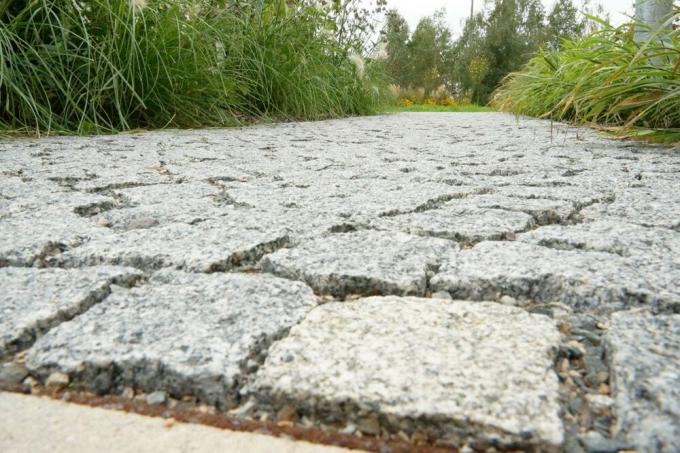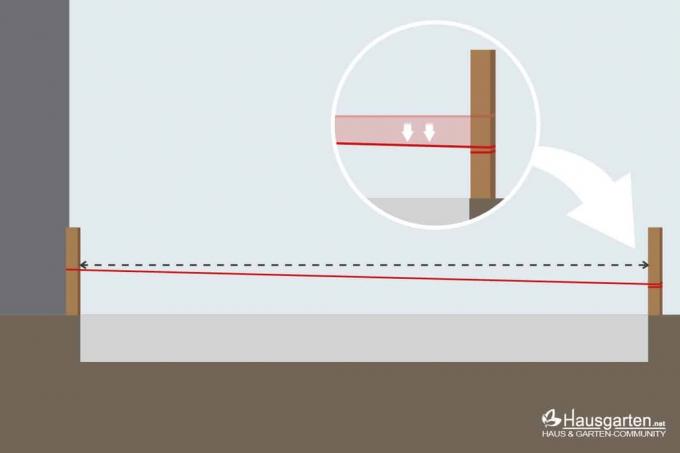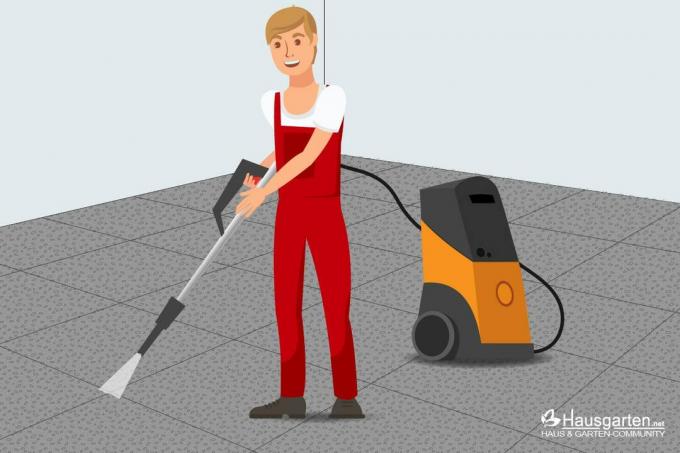

Table of contents
- Cobblestones - Types
- Preparation
- Clean concrete pavers
- cleaning
- post-treatment
- Stones made of natural stone and granite
- cleaning
- post processing
Different types of pavers laid on a driveway, patio or garden path, When soiled by cement, they also require various cleaning methods, which the following article will deal with occupied
Cobblestones - Types
When we talk about paving stones, these are usually slabs that are to be laid outdoors. Therefore, due to the stress, they are also stones that have to withstand a lot. The conventional stones for the garden, the terrace or a yard or garage entrance are made from the following materials:
- concrete
- granite
- natural stone
Since these materials all behave differently, some absorb moisture and some are also sensitive react to scratches, they should also be cleaned in various ways if they are soiled by cement stains become.
Preparation

Regardless of the type of paving stones used, the preparation must be carried out. First, the entire surface should be gently cleaned. It is important here that there are no small granules on the surface that could damage the stones during later cleaning and scratch them:
- Use brooms with soft bristles
- sweep everything together
- Leaves, dust, sand or other loose dirt
- then rinse with a water hose
- Let the surface dry
Tip:
If you carry out this preparatory cleaning regularly, the surface will always remain nice and clean, and weeds can also be prevented from settling in the joints or moss on the stones.
Clean concrete pavers
Concrete blocks are not natural, they are factory made. For this reason, these stones are also less sensitive to cleaning processes, especially when solid, dripping cement stains have to be removed.
cleaning
Once the surface has been prepared and loose dirt removed, the stubborn cement stains must be removed. If these are already hard, they should be carefully scraped off with a spatula, if possible. Remove the scraped cement from the surface with a dustpan and hand brush and then proceed as follows:
- 10 liters of boiling water in bucket
- Add 10 grams of soda
- mix well
- put on the surface
- ideally pour into a watering can and pour
- spread evenly over the paving stones with a soft broom
- alternatively use a puller
- protect eyes
- Soda water can cause eye irritation
The soda-water mixture brings the cement parts, which have already entered the pores of the concrete blocks and result in unsightly dark spots, back up to the surface.
A notice:
If the cement stains are not yet dry, you can remove them more easily. In the case of loose, still damp adhesions, these can simply be lifted off the stone with a spatula and placed in a bucket. The remaining stains are then further cleaned as described above.
post-treatment
In the post-treatment, after the soda-water mixture has been applied, proceed as follows:
- leave on for five hours
- then wash off with clear water
- let dry well
- repeat if necessary
If only individual areas are affected by the cement stains, they can also be treated precisely with the soda-water mixture. It is then not necessary to clean the entire surface in this way.
Tip:
However, unless they are new pavers that have been laid and soiled with cement, they often are but it makes more sense to clean the entire surface with soda water so that a uniform color can be achieved again can.
Stones made of natural stone and granite

With paving stones made of natural stone or granite, it can be easy to remove stains with the wrong ones cleaning agents can cause scratches or bleached areas that cannot be removed even by polishing permit. Therefore, these stones must be cleaned more gently, which unfortunately does not always achieve the desired goal. Because stubborn cement stains, which may have already penetrated the pores of the stone, are often very stubborn.
cleaning
Natural stones must not be cleaned with soda. Only lukewarm and not hot water should be used here:
- Pour lukewarm water into a bucket or watering can
- Use stone oil or neutral soap
- Use stone oil according to the manufacturer's instructions
- stir well
- give up on the surface
- let act
Tip:
It makes sense to only carry out cleaning when the weather is good. If rain is forecast, it can fall on the surface during the exposure time, especially five hours, and water down the mixture and make it unusable.
post processing
After about 30 minutes exposure time, the area or individual spots with stains can be treated with a brush to loosen the dirt from the cement. Then spray the entire area with the hose and, if necessary, repeat the procedure for stubborn stains.
 Home editorial office
Home editorial office
Learn more about building a terrace

Effectively remove lichen from paving stones
A covering of lichen on paving stones not only looks ugly, but also poses the risk of slipping. With the following tips, you can easily and effectively remove unloved roommates from your patio and garden paths.

Distance between decking boards | Information on terrace construction
A correct distance between the terrace boards and the substructure determines the longevity of a terrace. Only well-ventilated wood dries out optimally to prevent the formation of mold and rot. Last but not least, the movement tolerance plays another decisive role.

Lichen: remove white spots on paving stones
In addition to mosses, yellow-white coverings often adorn the paving stones of our driveways. It is not uncommon for dull stains to spoil the joy of the new stones shortly after they have been laid. Although sometimes wrongly dismissed as an indication of poor material quality, this is actually a natural phenomenon.

Determine the gradient on a terrace: this is how it works
Rain, snow or ice, depending on the weather, water collects on the patio floor. The terrace needs a slope so that no annoying puddles form on it. Calculating the slope is easy once you know the length and material of the decking.

Terrace construction: the 1×1 of the substructure
When constructing a terrace, the substructure plays a decisive role in determining the service life. However, it must also be tailored to the respective material and the substrate. Here you can find out what to look out for.

Laying a wooden terrace on exposed concrete slabs: this is how it works
A wooden deck is warm and natural, welcoming and cosy. But what if you already have a terrace made of exposed aggregate concrete? This is not a problem but an advantage. Because this can be used directly as a basis. We show how.
